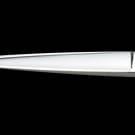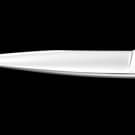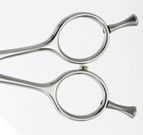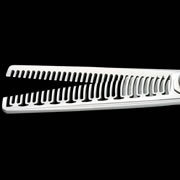 Glossary for scissors
Glossary for scissors
We explain glossary for scissors clearly.
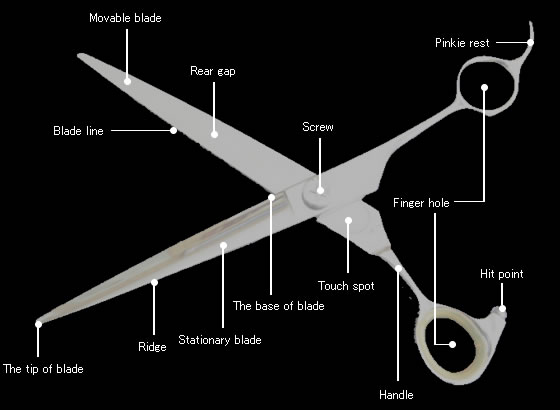
Appellation of each part of scissors
| Stationary blade: | Insert the ring finger into the finger hole of the Stationary blade and do not move the ring finger. It is also called Top blade. |
| Movable blade: | Insert the thumb into the finger hole of Movable blade and move only this side to open and shut scissors. It is also called Bottom blade. |
| Rear gap: | A dent on the rear face of a blade. Both blades tend to bite into inside due to the presence of the rear gap. |
| Blade line: | An edge line of the rear face of a blade, where actually cut hair. It is ideal that the blade line is narrow and constant width from the base to the forefront. |
| Touch spot: | A spot where Stationary blade and Movable blade contact each other. The more smooth it is, the less tired the performers tend to get. It needs to be cleaned and lubricated often because it is worn due to friction. |
| Screw: | An important part to assemble both blades, a fulcrum. It consists of shaft, nut, gasket, washer and bearing. The variety and characteristics of screws are as follows.
|
- To expand the image, please click the picture.
| Hit point: | A contact spot when scissors are completely shut, it absorbs shock. It is usually made from rubber or plastics, but it is exchangeable for metal. This process is called buzzing process. |
| Pinkie rest: | A spot where the pinkie rests. There are one body type and screwed type. Many users don't need the pinkie rest depending on preference. The specification which eliminates the pinkie rest from the one body type is called NF (NO FOOK). |
| Finger hole: | A space where insert finger into. It is adjustable with finger hole adjuster ring when it is too large. It is also possible to widen the hole. Note 1. In case Thinning scissors with right blade Stationary blade:→Comb blade Movable blade→Stick blade Replace as above-mentioned. Note 2. In case Thinning scissors with Counter blade Stationary blade:→Stick blade Movable blade→Comb blade Replace as above-mentioned. Note 3. In case Thinning scissors with both comb blade, it is the same as cutting scissors. |
Unit indication
| The size is exhibited in inch units. The entire length and the length of a blade are exhibited in mm units. The pinkie rest isn't included in the size. |
 |
Material of blade
| Carbon steel: | This has been used for swords since old times and its composition is mainly iron including carbon. Someone likes its particular sharpness, but it is rarely used nowadays because it is corrosive. |
| Stainless steel: | This is alloyed steel, which includes iron, chrome, molybdenum, tungsten and vanadium and it has strong rustproof characteristics and luster. |
| Cobalt-base alloys: | This is alloyed steel, whose base is stainless steel including cobalt and it has strong wear and abrasion resistance and its sharpness lasts for a long time. Hitachi 440C and Hitachi ATS314 of our lineup correspond to this. |
| Stellite: | Its main composition is cobalt including chrome and tungsten, it has strong wear and abrasion resistance and its sharpness lasts for a long time, but it is too expensive and difficult in machining. |
Structure of blade
| All steel: | It is currently used for mainstream blades and it is entirely made of the same material. It has less warpage and it is easy to process. |
| Coalesced steel: | Steel coalesced with soft metal. Although it has dispersed propensity in expansion and contraction phenomena by heat due to the same principle as bimetal and it is difficult in machining and adjusting, many people prefer its particular sharpness because of its strength and litheness. This structure is applied to KEIUN and Japanese swords. |
Material of handle
| Stainless: | It is used because it is not hardened and has beautiful luster and strong rustproof and corrosion resistant characteristics. The reason why the same material as blades isn't used is because it is easy to adjust blade's bite and handle's warpage in assembly. However Damascus steel which is not hardened is used for KEIUN except for alto. |
Method to attach handle
| Whole body forging: | Forge after welding precut (pre-sheared) blade material with handle material. Its strength is high but the handle shape is not alterable. |
| Lost wax: | Weld forged blade with rough shaped handle. It has slightly less strength but its blade shape and handle shape is selectable depending on preference. |
Blade shape
| Step blade: | Its blade surface is almost straight. Its cross section is oval shape and suited for Caucasian hair, but it isn't suited for Asian hair because their round and thick shape need more strength. It tends to disperse cut hair. |
| Sword blade: | The center of this blade is chevron and a single line extends along the entire length. There are two options, one is to select sword blade for stationary blade only, and the other is to select sword blade for both stationary and movable blades. |
| Clam blade: | Its shape has a smooth R from the ridge to the edge of the blade. Altough it is thought before that sword blade has more strength, there is no problem in selecting depending on preference. It is current mainstream. |
| Sasaba blade: | The width of the blade is wider than clam blade and its R is more gentle. It is often used for dry cutting because it enables hairs to evade. |
- To expand the image, please click the picture.
Handle shape
| Eyeglasses type: | With regard to this handle, stationary blade and movable blade are disposed in line symmetry. Although it tends to make performer get tired because performer should straighten their elbow, right blade can serve as counter blade because thinning scissors can be used upside down. |
| Offset type: | Its finger hole of movable blade is disposed nearer to the blade edge than that of stationary blade. It doesn't make performer get tired because they can freely move their elbows and wrists. |
- To expand the image, please click the picture.
Proper choice of cutting scissors
| Rough cut scissors: | It is used to roughly arrange hair style. It is required to cut large amount of hairs, so long and powerful type is mainstream. The blade angle is about 45 degrees and it is a popular angle. |
| Medium cut scissors: | It is used to roughly finish hair style. Its length is shorter than rough cut scissors. The blade angle is about 45 degrees. |
| Finishing scissors: | Its length is generally short, and its tip is sharp and its blade width is rather slim in general because it requires to adjust for finishing and to practice intricate operation. The blade angle is about 45 degrees. |
| Direct scissors: | It is used in operations when scissors crawl on scalp such as crew cut and square cut. The blade angle is from 35 to 40 degrees. Its sharpness dese not last for a long time because of its acute angle. |
| Dry cut scissors: | It is used to cut dried hairs. Because it is necessary to evade hairs especially its cuticles, the blade angle is obtuse angle of about 55 degrees. |
Proper choice of thinning scissors
It is used to adjust amount of hairs. Generally the tip of a comb blade grabs hairs and a stick blade cut them. There are a few cases where both blades are tapered or the comb blade and the stick blade are attached in reversed positions. This should be checked before maintenance.
Cut rate (thinning rate) is a ratio of the cut hair amount by thinning scissors compared to the cut hair amount by cutting scissors, and it is usually from 10 to 80 % and it is mostly from 20 to 30%.
| Right blade: | With regard to this type, the comb blade is the top side when performer grips scissors and this thinning scissors shall be moved downward of the head while cutting. If thinning scissors with right blade are moved upward, hairs will be hooked. Eyeglasses type thinning scissors are used as both right blade and counter blade. |
| Counter blade: | With regard to this type, the stick blade is the top side when performer grips scissors and this thinning scissors shall be moved upward of the head while cutting. If thinning scissors with counter blade are moved downward, hairs will be hooked. In addition when this is used for the Bob cut, the finish is beautiful because the cut end of hairs face inside. |
| Double comb blade: | With regard to this type, both blades are comb blade and generally the bottom blade is tapered. It tends to easily pull out from hairs because the area between combs is wide. But it isn't suited for users who tend to perform "push cut". ("Push cut" is to push the ring of movable blade by thumb while cutting and in this "push cut" the sharpness doesn't last for a long time because the movable blade rubs stationary blade and the blades are worn soon. And "pull cut" is contrary to the "push cut" and in the "pull cut" hairs are not completely cut but partially torn off. It causes split hairs.) |
- To expand the image, please click the picture.
- We produce and sell thinnimg scissors with permission to use the patent of Yamamura-MFG Co., Ltd.








